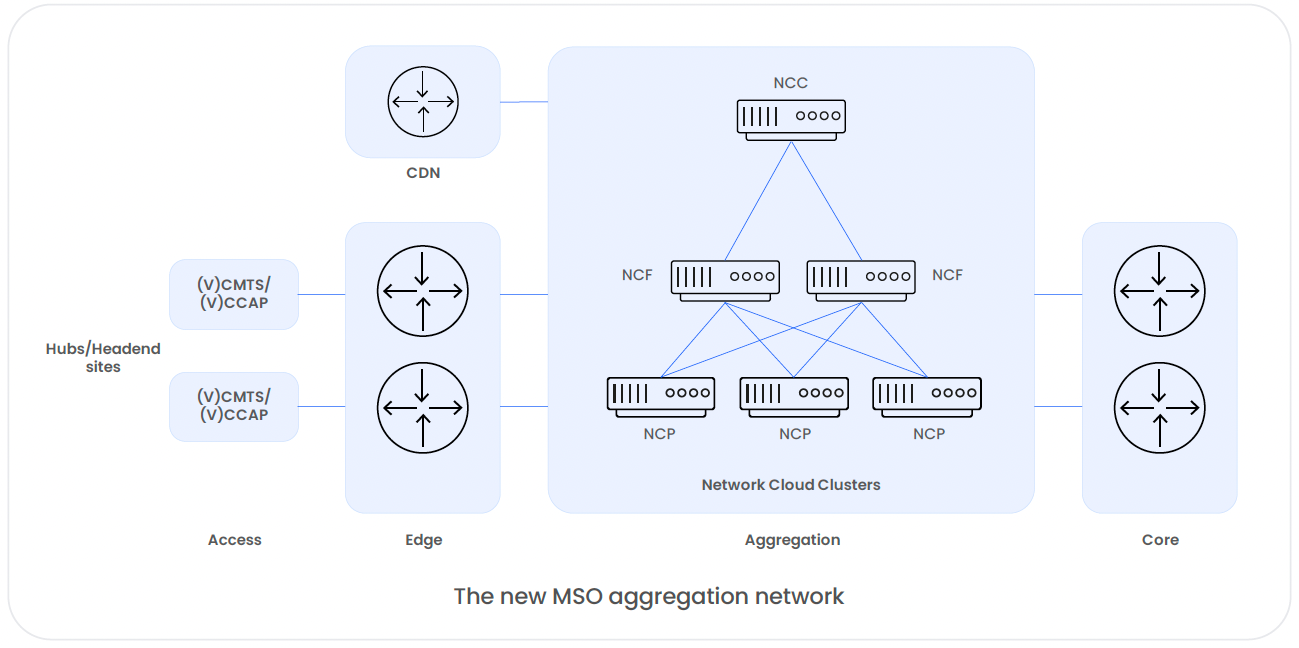Case StudiesMarch 27, 2024
Transforming Aggregation and Peering IP-network with a Disaggregated Solution
CHALLENGES
This cable MSO looked for an IP aggregation solution with the following requirements:
- Efficient scale: Secure granular scalability to address a forecast of 5+ years of growth
- Competitive pricing: Save on number of ports and total cost of ownership (TCO)
- Operational simplicity: Minimize circuit move operations and complexity over the solution lifecycle
- Improved network service: Limit outage blast radius in case of failure
- Interoperability: Seamlessly work with existing equipment in place and open networking solutions
- Architectural innovation: Evolve towards innovative software-driven solutions.
Given these requirements, the MSO evaluated two distinct types of solutions:
- Spine-leaf IP Clos architecture – utilizing a traditional, monolithic chassis-based solution as proposed by their legacy vendor.
- Distributed Disaggregated Chassis (DDC) architecture – an innovative, open, white-box-based solution endorsed by the Open Compute Project (OCP).
Considering their specific needs, the DDC-compliant DriveNets Network Cloud solution emerged as an innovative and competitive choice to meet their demands. It adeptly addressed the company’s challenges and requirements, efficiently delivering the anticipated benefits.
For more information about – Clos vs. DDC architecture.

SOLUTION
DriveNets Network Cloud perfectly addressed the MSO’s needs, delivering an open, scalable, cost-effective software-based network solution. Since 2021, more than 25% of the cable MSO’s traffic was migrated to the new aggregation and peering IP-network, which includes 14 deployed sites with 2 large clusters (CL-192) and 12 medium clusters (CL-96).
The solution include:
- DriveNets Network Operating System (DNOS)
- DriveNets Network Orchestrator (DNOR)
- Networking white boxes, based on Broadcom Jericho 2 NPU chipsets
- Field system integration and deployment, carried out by a leading system integrator of network solutions, both legacy and disaggregated
In the next phase, the cable MSO plans to re-architecture the entire network and to expand DriveNets Network Cloud deployment to the network edge.
“DriveNets Network Cloud allows us to reduce the operational effort of growing our IP aggregation network’s capacity. It removes the effort, complexity and costs associated with line card upgrades and chassis life-cycle management, while providing us more control of our network. Overall, DriveNets solution is very scalable and flexible while helping us to save on costs.” Senior Network Executive, Leading North American MSO
RESULTS
By deploying DriveNets Network Cloud, the cable MSO achieved the following benefits:
- Efficient, highly scalable: Granular scalability, expanding the hardware infrastructure only when needed, while limiting the operational burden of managing the growing distributed clusters as single virtual entities.
- Low TCO: Reduced number of physical ports vs. chassis, reduction of expensive interconnect ports in the spine and leaf architecture (IP Clos model), low-cost white boxes.
- Low operational burden: Single, shared management via software; simple operations, with ease of planning, deployment, engineering, maintenance and troubleshooting through automation and architecture simplification; circuit move elimination over the five-year solution lifecycle; and minimum blast radius across the DDC solution in case of component failure.
- Full interoperability: Full network protocol interoperability with legacy vendors, requiring no alterations to existing configurations or architectures.
- Future-proof: DriveNets is an established, innovative vendor, part of a large, open ecosystem of ODM vendors and partners; DriveNets solution is ready to scale beyond a five-year forecast, up to 819Tbps per cluster
SUMMARY
The implementation of DriveNets Network Cloud marked a significant transformation in the MSO aggregation networks, its capacity expansion and operational management. By adopting DriveNets Network Cloud, the cable MSO substantially reduced the operational efforts traditionally required for network scaling.
DriveNets has eliminated the complexities and expenses tied to line card upgrades and chassis lifecycle management, streamlining the MSO operations. More importantly, the new IP aggregation solution has enhanced control over the network, allowing the MSO to achieve more effective and efficient management.







